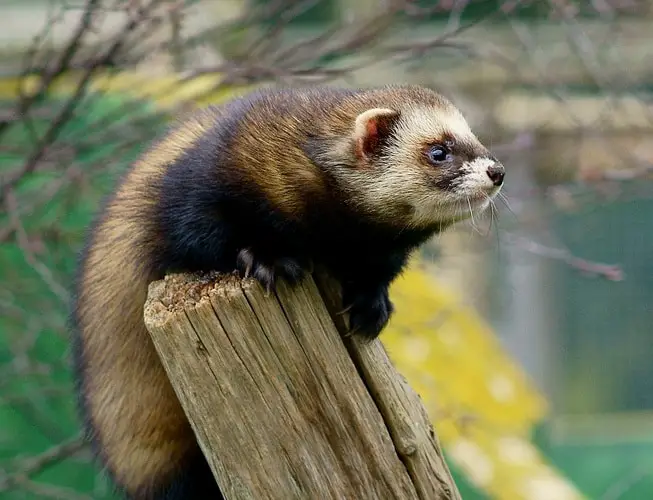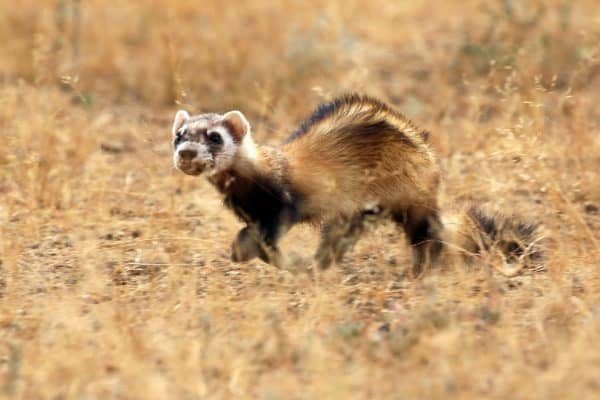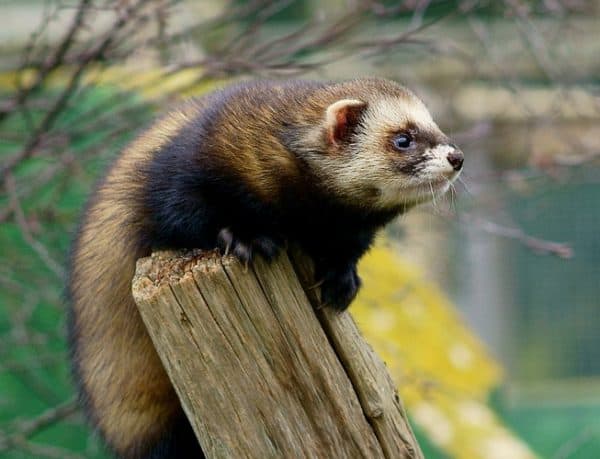Mustelids are a family of strictly carnivorous mammals, which include a quite wide range of different species across different subfamilies. The most popular ones are the ferrets, weasels, otters, minks, martens, and wolverines. And while ferrets are becoming more and more popular as pets, the wild ferrets don’t thrive as well as they used to.
In this article, we’ll talk about wild ferrets and different other Mustelids, where they live, what they eat, and how important they are to the ecosystem.
Types of Wild Ferrets & Mustelids
There are three different types of wild ferrets and two very similar Mustelids species. North America has the Black-Footed Ferrets, Europe has the European Polecats, and Asia has the Steppe Polecats. They have a very similar origin and it seems that ferrets have been around for a very long time. The other similar animals are none other than the weasels and the minks.
In the wilderness, every single species of the Mustelid family has its own purpose. They are an important part of a healthy ecosystem as they maintain rodent populations under control, while also serving as a great food source for other predators, such as owls. Each type of wild ferret thrives on the food available where they live and their diet can include a wide range of different animals. This includes mice, rabbits, birds, and even fish.
Ferrets in the wild tend to have a pretty short lifespan that ranges between 1 and 5 years, but very few ferrets make it past the 3-year mark. Besides predators, lack of food, and diseases, some wild ferret populations have serious inbreeding problems. This is because they are mainly polygamous creatures and males typically impregnate numerous females each breeding season.
Wild ferrets can also destroy an ecosystem if they are introduced to the wrong area. This is because they are very similar to cats, which means they are excellent hunters that can kill a very wide range of creatures and drive them to extinction.
Birds are specifically at risk from ferrets as these predators have an excellent sense of smell, great low-light vision, are very silent, and are extremely fast. More than that, some wild ferrets live and hunt in groups.
Weasels are widely known for their destructive nature and are often considered vermin, especially by farmers. This is because, despite being small in size, a single weasel can catch and carry an adult chicken or duck without much effort.
They’re also infiltrating artists and they can usually break even into the most secure cages. Their bodies are very long and slender, allowing them to squeeze almost anywhere. And if they can’t take the prey with them, they will eat as much as they can before leaving.
Black-footed Ferrets (North America)
Black-Footed Ferrets are the only species of ferret that is native to America, which is why they’re also named American Polecats. They get their name from their distinctive-looking feet that are all black to a different degree, along with the tip of their tail. Their base color is yellowish, but they have black outlines all over their body and a very dark mask around their eyes.
 These ferrets used to thrive throughout history everywhere from southern Canada to northern Mexico. But in 1979 they were considered extinct. Luckily, a few small populations were rediscovered and the United States Fish and Wildlife Service made all the effort they could to bring them back from the brink of extinction. Now, there are thousands of wild-born Black-Footed Ferrets and they are off the extinction list.
These ferrets used to thrive throughout history everywhere from southern Canada to northern Mexico. But in 1979 they were considered extinct. Luckily, a few small populations were rediscovered and the United States Fish and Wildlife Service made all the effort they could to bring them back from the brink of extinction. Now, there are thousands of wild-born Black-Footed Ferrets and they are off the extinction list.
One of the biggest difference between these ferrets and the others is their preference for solidarity. They each occupy a certain area and they don’t hunt on each other’s ground. Sometimes, females have their territory inside a male’s territory, which is a lot bigger. But males are 100% separated and the encounters can get violent. Other ferrets create groups called business and they almost never live alone.
Throughout history, and even today, Black-Footed Ferrets thrived on a diet of prairie dogs. This is where they also got the name of “Prairie Dog Hunters”. They hunt both white-tailed and black-tailed prairie dogs but they thrive better on the black-tailed ones. This is because the white-tailed prairie dogs have a 4-month hibernation season each year.
American Polecats can hunt other types of prey as well. This includes mice, voles, deer mice, western meadowlarks, horned larks, upland sandpipers, thirteen-lined ground squirrels, white-tailed jackrabbits, and a lot more. They are also active during the winter, but if the cold is too much for them, they can stand inside their burrows for up to 6 days.
European Polecats (Europe)
European Polecats are native to Europe and North Africa and they have been around for a very long time. They’re generally dark brown with a pale underbelly and a dark mask across their face. But color mutations are also possible as albinos and erythrists can occur from time to time. However, due to their easy-to-spot fur color, albino European Polecats have a very short lifespan, which is why they are very rare in the wild.

Today, European Polecats thrive throughout most of rural Wales and in England. They can be found from Cheshire south to Somerset, and east to Leicestershire and Northamptonshire. Sadly, they went extinct in most of England and they only survived in Wales, where numerous populations have spread over the border.
The reason why they went extinct in most of England is that they were considered vermin and were heavily hunted. This is because they live in groups, they breed very quickly, and they hunt a wide range of small animals. Just a small population can drive birds to extinction if they are introduced to the wrong place. But they’re also great at controlling small rodent populations and they’re a good food source for other predators.
Around 2,000 years ago, some European Polecats have been domesticated to help with vermin control as they are incredible hunters and don’t require much food to survive. Today’s popular pet ferrets are the descendants of these domesticated European Polecats. Wild specimens are almost nothing like their popular counterparts and they can be extremely aggressive.
These ferrets are not as agile as weasels but the fact that they live in groups gives them a big advantage. This is also why they managed to thrive a lot better than black-footed ferrets, which prefer living alone unless it’s the breeding season.
Wild European Polecats feed on small rodents, amphibians, birds, and even reptiles. They’re actually known for their disturbing crippling technique that leaves the victim alive but unable to do anything. They do this by piercing the prey’s brain with their teeth and then they store it, still living, inside their burrow for later.
Steppe Polecats (Asia)
Steppe Polecats are native to Central and Eastern Europe and Central Asia. They’re also known as the white, or masked, polecats. The most impressive thing about these polecats is their ability to adapt to different habitat modifications. This allows them to thrive for a very long time in different areas as they simply move around until they find another abundant source of food.

These ferrets are typically quite light in color and their base is usually yellowish. They also have dark legs and a mask across the face. It’s a bigger animal than the European polecat and it has a much more powerful skull. This allows them to easily hunt bigger prey as well. And although they typically go after young or injured marmots, they sometimes take on a healthy adult as well.
You can find these ferrets in various places across Europe and Asia. This includes southern Russia, northern Georgia, Tajikistan, Uzbekistan, Turkmenistan, Kazakhstan, Kyrgyzstan, Mongolia, and northern and western China. And more impressively, they have also been recorded living at an elevation of 16,570ft in Upper Mustang, Annapurna Conservation Area, Nepal.
Similar to their European counterpart, Steppe Polecats were used to get rid of vermin all across Russia and other different places. Just a single Steppe Polecat can destroy at least 200 ground squirrels each year, ow around 1,500 mouse-like rodents in just a single winter. These polecats can withstand colder temperatures but they prefer moving around the nicer weather each year.
Steppe Polecats preys on steppe-dwelling mammals, which is also how they got their name. This includes marmots, ground squirrels, pikas, etc. And if squirrels are not around very often, they switch to preying on water voles, fish, chickens, grey partridges, willow grouse, etc. Unlike the European Polecat, the Steppe Polecats very rarely eat reptiles and amphibians.
Mink
Minks are semi-aquatic and strictly carnivorous. There are two species that are known as “Mink”, which are the American Mink and the European Mink. There was also a sea mink that was closely related to the American Mink but it went extinct somewhere in the 1860s. Today’s minks are typically dark-colored and are very searched-for all over the world for their fur.
Wild Minks are also excellent hunters and they can harm the ecosystem if they are introduced to the wrong areas. This can happen if they escape captivity or are simply released by animal rights activists without thinking about how they can affect the local ecosystem. This has lead many countries to ban them as pets and order any trapped minks to be killed humanely.
Today, Minks can be found across Europe, including Denmark and Great Britain, and South America. It’s hard to tell American and European Minks apart, but it’s possible without looking at their skeleton.
All European Minks have a large white patch right on their upper lip, while only very few American Minks have this marking, and it’s a lot less visible. This means that any Mink that lacks the patch of white is certainly part of the American species.
Minks thrive on fish and various similar aquatic life. But they also prey on birds, small mammals, eggs, and some adult Minks tend to eat the young Minks, especially if they belong to other males. Despite being semi-aquatic creatures, their favorite food is actually rabbit meat.
When it comes to territory, male Minks stay away from each other’s home areas. They might accept females now and then, which is why their territories might overlap. But male Minks always attack one another.
Weasels
Weasels are the most adaptable species in the Mustelidae family. They can thrive on a very wide range of animals and they are found all over the world. Long-tailed Weasels thrive in North America, tropical Weasels live in South America, Japanese weasels can be found in various forests, suburbs, and villages across Japan, etc.
Their bodies are very long and slender, which allows them to easily enter even the most crowded spaces. Females are smaller than males but not by much. They all have a red or brown upper coat and their bellies are always white. There are also some very special populations that can moult to a wholly white coat in winter.
Weasels are often considered vermin as they often steal poultry from farms and rabbits from commercial warrens. However, they are also excellent natural rodent population controllers as they eat a wide range of rodents.
In the wilderness, weasels eat mice, voles, rats, rabbits, and even birds, frogs, and eggs. They are very determined and will squeeze through even the smallest burrows to try to get to their prey. While male ferrets tend to have a harder time going through burrows and females go in easier, this is not the case with weasels. This is because they are all very slender and can fit in most burrows.
Typical Diet For A Wild Ferret
A wild ferret is not very pretentious about its next prey, which is why it can be so dangerous in the wrong ecosystem. Their bodies are made to eat whole small prey and their diet remained pretty much the same throughout history. Even their ancestors ate the same types of animals. Their digestive systems never evolved much, which means that ferrets still have a short and fast digestive system.
And while they’re capable of breaking down the whole prey, including its meat, bones, fur, feathers, and skin, they need highly nutritious food to truly thrive. This is because their digestive system is too short to manage to take all the nutrients it needs from a single meal. Their metabolism is also very fast, which forces them to eat frequently, making them kill numerous times a day.
The types of animals a ferret can eat are countless as they can consume pretty much any living creature that they can catch and eat. This is a big reason why they are excellent population controllers in areas that have trouble with vermin. They can bring down entire populations of rabbits, mice, rats, moles, prairie dogs, etc.
Their incredible hunting skills are also why some ferrets were domesticated a few hundred years ago. They’re smaller than dogs and much more efficient at emptying burrows. In fact, there are people that still use ferrets for hunting instead of dogs to this day. And most of the time the ferrets are repaid with a part of the game they catch. This includes anything from rabbits to rats and moles.
Besides rodents, ferrets love hunting birds as well. This includes smaller birds that come down looking for worms and are too slow to fly away when they notice a ferret nearby. But ferrets can also be bold enough to attack geese and other bigger birds. And if they lack a good food source, they can eat fish and even snakes from time to time.
Frequently Asked Questions
Can you find ferrets in the wild?
There are three different types of ferrets that thrive in the wilderness all over the world. Black-Footed Ferrets, which are also known as American Polecats, European Polecats, and Steppe Polecats that live in Asia. These are wild-born ferrets that have made their own population and are self-sustained. The home ferrets that are found on the market come from the European Polecat and they’ve been domesticated for hundreds of years.
Are there wild ferrets in the US?
There is only one specie of ferret native to the U.S., which is the Black-Footed Ferret, also named the American Polecat. These ferrets have almost gone extinct in 1979 but as of today, they left the extinct list and rejoined the endangered list. This is thanks to the United States Fish and Wildlife Service that worked very hard to save the species and reintroduce it into the wilderness.
Are wild ferrets dangerous?
If wild ferret populations grow too much, the local ecosystem can be turned upside down as they are killing machines that eat anything from mice to rabbits and to birds. And if you’re bitten by a ferret, you should seek medical help as soon as possible as germs can get spread through their bites and scratches. They can have rabies or be seriously infected. Young children tend to have the highest risk of getting sick from an encounter with a wild ferret.
What animal family are ferrets from?
Ferrets belong to the Mustelidae family, which translates to “Weasel”. This family includes polecats, ermines, and stoats. And the ferrets that are sold as pets come from the European Polecat and have undergone hundreds of years of domestication.

